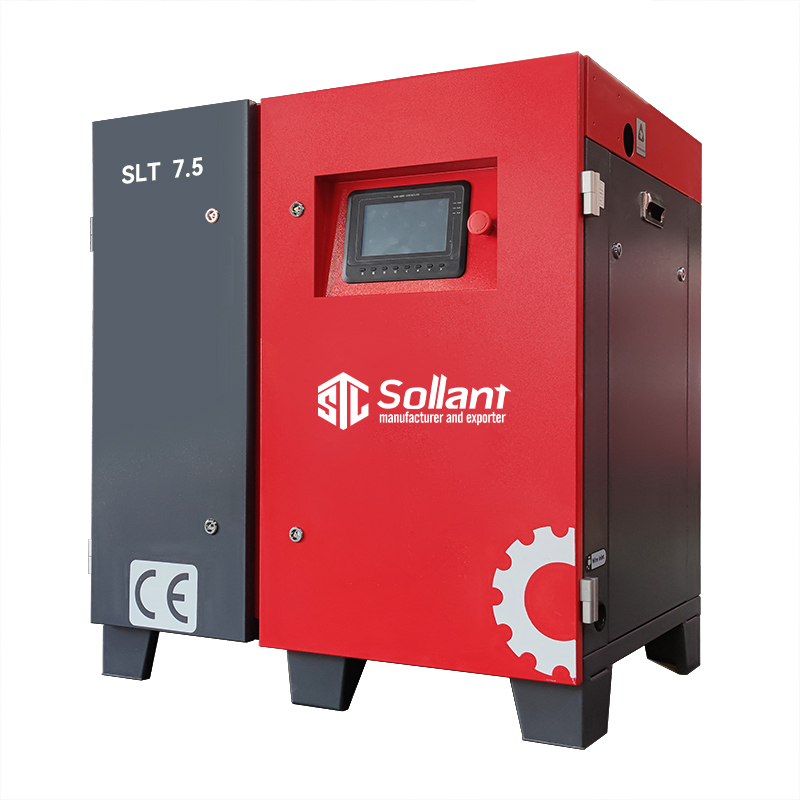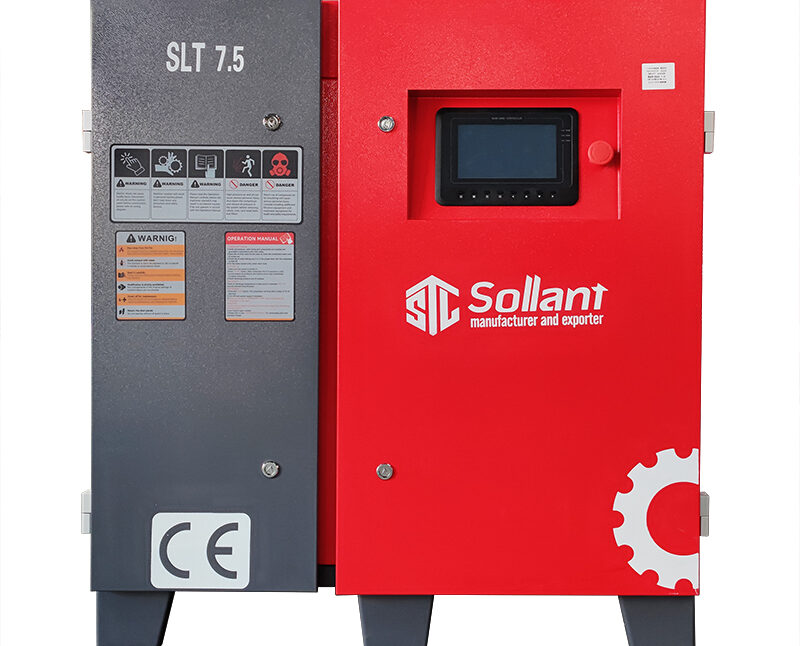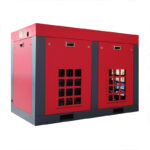Introduction
Screw air compressors play a vital role in modern industrial production due to their high efficiency, reliability, and broad application range. However, one of the most common issues affecting their performance is high temperature, which can lead to equipment failures, production interruptions, and even serious safety hazards.
To ensure the safe, stable, and efficient operation of screw air compressors, it is crucial to diagnose and resolve high-temperature problems effectively. In this article, we will explore the causes, diagnostic methods, and 10 powerful solutions to help you prevent and fix overheating issues in your screw air compressor.
1. The Dangers of High Temperature in Screw Air Compressors
Excessive temperatures in screw air compressors can lead to serious consequences, including:
1.1 Equipment Damage
- Lubricant Deterioration – High temperatures accelerate oxidation, reducing lubrication and cooling efficiency.
- Seal Aging – Heat speeds up the degradation of rubber seals, leading to air or oil leaks.
- Bearing Wear – Overheating increases friction, causing bearings to wear out faster.
- Rotor Jamming – Thermal expansion can lead to rotor blockage or seizure.
1.2 Production Interruptions
- Unexpected Shutdowns – Many compressors have built-in high-temperature protection that causes automatic shutdowns.
- Long Maintenance Delays – Cooling and repairing high-temperature faults wastes valuable production time.
1.3 Safety Risks
- Fire Hazards – Overheated oil can ignite, leading to fire risks.
- Explosion Risk – Compressed air and lubricant vapors may cause dangerous explosions.
1.4 Increased Energy Consumption
- Reduced Efficiency – High temperatures lower the compressor’s efficiency, increasing energy costs.
- Cooling System Overload – The compressor’s cooling system works harder, consuming extra energy.

2. Common Causes of High Temperature in Screw Air Compressors
Several key factors contribute to overheating problems:
2.1 Cooling System Failures
✅ Cooler Blockage – Dust, oil, and debris reduce heat dissipation efficiency.
✅ Cooling Fan Malfunction – Broken or deformed fan blades cause poor airflow.
✅ Water Cooling Issues – Low water flow, high water temperature, or poor water quality impact cooling performance (for water-cooled compressors).
2.2 Lubrication Problems
✅ Deteriorated Oil – Old or oxidized oil loses lubrication efficiency.
✅ Low Oil Levels – Leaks or insufficient oil lead to increased friction and heat.
✅ Wrong Oil Type – Using incorrect viscosity oil reduces cooling performance.
2.3 Overloading the Compressor
✅ Blocked Air Intake – Dirty air filters reduce airflow, increasing workload.
✅ High Exhaust Pressure – Blocked exhaust pipes increase pressure and heat buildup.
✅ Continuous Overuse – Running the compressor without sufficient breaks causes heat accumulation.
2.4 Control System Malfunctions
✅ Faulty Temperature Sensors – Inaccurate readings fail to detect overheating in time.
✅ Temperature Control Valve Failure – Improper valve function disrupts oil flow, leading to overheating.
✅ PLC System Issues – Malfunctioning PLCs can lead to incorrect temperature control settings.
2.5 Environmental Factors
✅ Poor Ventilation – Heat accumulates if the compressor is in an enclosed or poorly ventilated area.
✅ High Ambient Temperatures – Hot surroundings increase the compressor’s workload.
3. Diagnosing High-Temperature Problems in Screw Air Compressors
✅ Step 1: Observe Equipment Performance
- Check temperature displays and look for error codes.
- Inspect for abnormal vibrations, noises, or oil leaks.
✅ Step 2: Inspect the Cooling System
- Clean the cooler to remove dust and oil buildup.
- Check the cooling fan, blades, and motor for damage.
- Verify cooling water flow (for water-cooled compressors).
✅ Step 3: Check Lubrication System
- Ensure oil levels are within the recommended range.
- Inspect oil color, viscosity, and contamination.
- Clean or replace the oil filter.
✅ Step 4: Assess Equipment Load
- Examine air filters for clogs.
- Check for blocked exhaust pipes or faulty valves.
- Monitor pressure settings and airflow requirements.
✅ Step 5: Test the Control System
- Calibrate or replace temperature sensors.
- Ensure the temperature control valve operates smoothly.
- Test the PLC program and logic settings.

4. 6 Effective Solutions to Prevent & Fix High Temperature Issues
4.1 Regular Maintenance & Cleaning
🛠️ Clean the Cooler – Remove dust and oil buildup from cooling surfaces.
🛠️ Replace Lubricant Regularly – Follow the manufacturer’s recommended oil change intervals.
🛠️ Check and Clean Filters – Ensure air and oil filters are clear of debris.
4.2 Fix Cooling System Issues
🌡️ Unblock Coolers – Use compressed air or solvent to clean the heat exchanger.
🌡️ Repair Cooling Fans – Replace broken blades, motors, or belts.
🌡️ Ensure Proper Water Cooling – Check flow rate, water quality, and system integrity.
4.3 Address Lubrication Issues
🛢️ Maintain Correct Oil Levels – Regularly inspect and top-up lubricating oil.
🛢️ Use Manufacturer-Approved Oil – Ensure oil meets viscosity and thermal stability requirements.
4.4 Reduce Equipment Overload
⚙️ Replace Blocked Air Filters – Ensure sufficient air intake.
⚙️ Monitor Exhaust Pressure – Prevent excessive back pressure buildup.
⚙️ Avoid Continuous Overuse – Implement cool-down periods.
4.5 Optimize Environmental Conditions
🌬️ Improve Ventilation – Ensure adequate air circulation around the compressor.
🌬️ Control Room Temperature – Use air conditioning or cooling fans in hot environments.
4.6 Upgrade Control Systems
🔧 Replace Faulty Sensors – Ensure accurate temperature monitoring.
🔧 Repair Temperature Valves – Prevent oil circulation failures.
🔧 Optimize PLC Settings – Fine-tune control logic for better efficiency.
Conclusion
High temperatures in screw air compressors can cause severe damage, production losses, and safety risks. However, by understanding the root causes and applying the right preventive measures, you can effectively control overheating issues and extend the life of your equipment.
By following these 10 powerful solutions, you can ensure smooth, safe, and energy-efficient operation, minimizing downtime and maintenance costs.
💡 Need professional air compressor maintenance? Contact us for expert solutions!
Analysis of the reasons for oil shortage in screw air compressor:


